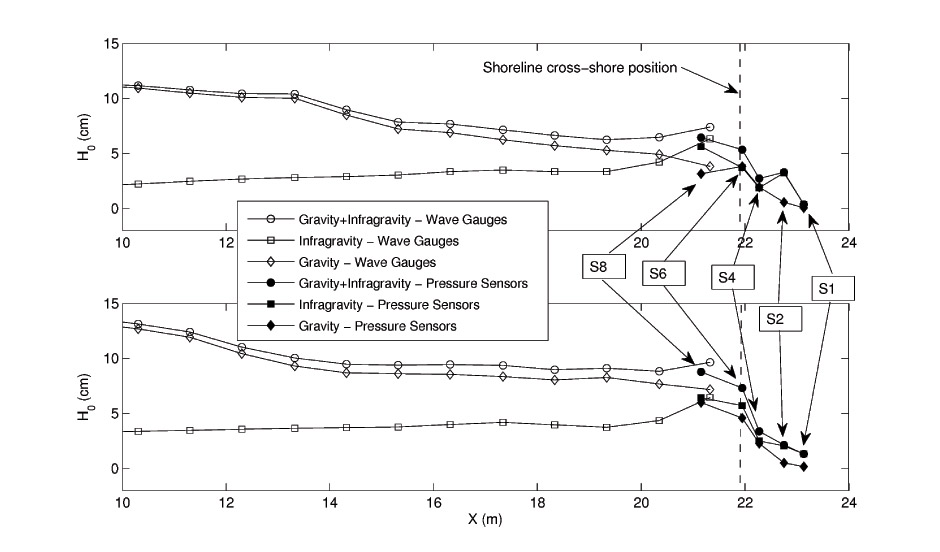Swash-groundwater dynamics in a sandy beach laboratory experiment
During the last two decades, a wide variety of field works, laboratory experiments, numerical simulations and analytical studies helped us to better understand the main features of the swash zone hydro- and morphodynamics. A particular attention has been paid to the interaction between the swash and the groundwater dynamics.
However, due to the harsh nature of the swash environnement, a number of processes are still poorly or partially understood, and further research efforts are necessary prior to understood. Very few laboratory studies have been performed to study the swash zone of porous beaches under controlled conditions. By combining high spatial and temporal resolution measurements of both free surface and groundwater dynamics in a sandy beach laboratory experiment, our work aims to bring new insight into swash zone / groundwater processes.
Two contrasting cases have been selected to demonstrate how different gravity and infragravity wave forcings affect the response of the groundwater-swash system.
Experiments are carried out at the SOGREAH LHF facility, G-INP, 30m x 30m, in order to study the swash-groundwater interaction.
An overview of the studied cross-shore profile can be seen in Fig. 1. The sand layer lies on a gravel base covered by geotextile. The inland boundary layer is a wall. The instrumentation is deployed on a fixed cross-shore section at the basin center. The wave maker generates waves over a flat rigid (concrete) bottom which then propagate over a mobile sand bed.
The cross-shore bathymetric profiles for the two cases are shown in Fig. 1, where « start« and « end« correspond to the profiles measured before and after the considered case. In both cases, the overall beach profiles can be classified as intermediate but the beachfaces are quite steep and can be considered as reflective.
Case 1 initially shows a double-bar system, with a significant trough and a shallow inner bar. In case 2, one notes the presence of a further offshore and deeper offshore bar and more regular surf zone and upper beach profiles.
The study is based on the comparison of two selected cases which differ by the wave forcing conditions (case 1: \(H_s=12cm\) and \(T_p=3.5s\), case 2 : \(H_s=15cm\) and \(T_p=2.3s\)), the features of wave breaking in the surf zone, the presence of a standing wave attached to the beachface and the wave setup at the shoreline. Significant differences are observed in the response of the swash-groundwater system.
Fig. 2 shows the cross-shore evolution of the root mean square wave amplitude in infragravity and gravity bands for both cases. Cases 1 and 2 show different behaviors due to different beach profiles and different forcing conditions, which result in different input conditions for the swash zone.
In the gravity band, case 1 shows a strong dissipation across the surf zone but the presence of a significant standing wave induces both a decrease of amplitude at the node around x=21.2m (S8 sensor and last wave gauge) and an increase at the antinode attached to the swash zone around x=22m above the S6 sensor.
In case 2, wave energy dissipation is weaker and occurs on a shorter area, more swell energy reaches the shore at the S8 sensor, but the standing modulation in the gravity band is smaller. It is hence remarkable that the presence of a reflection-induced standing wave attached to the beachface enhances the swash dynamics in the gravity range and nearly compensates the stronger energy dissipation all over the surf zone.
In the infragravity range, case 1 shows smaller amplitude motions in the outer surf zone but the low frequency energy continuously increases toward the shore to reach comparable values for both cases at the S8 sensor.





